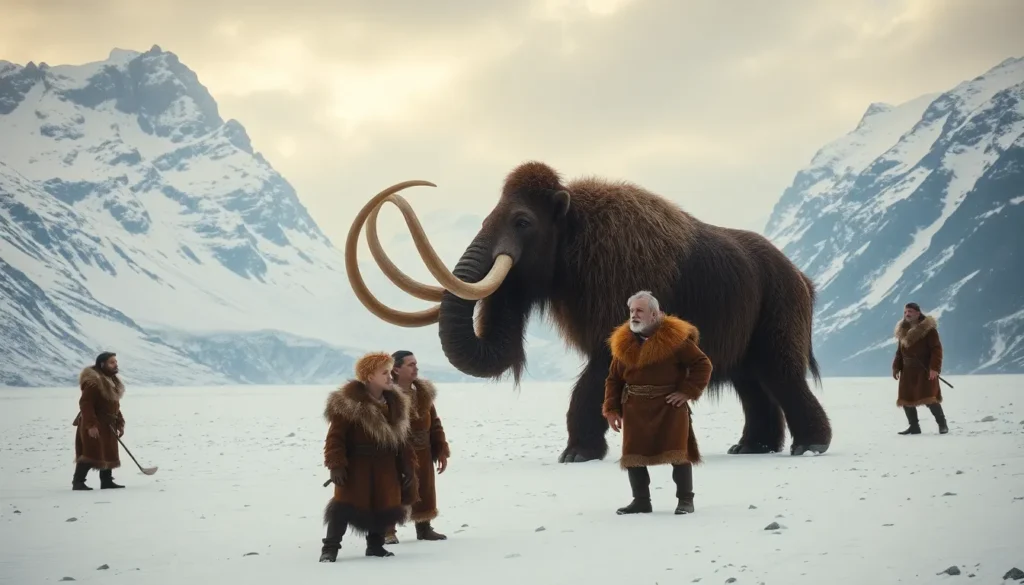Picture this: woolly mammoths roaming the Earth, glaciers stretching for miles, and cavemen trying to figure out fire while dodging frostbite. The Ice Age was an epic time in our planet’s history, but just how long ago did it all happen? Spoiler alert: it wasn’t just last weekend.
Table of Contents
ToggleOverview of the Ice Age
The Ice Age marks a profound period in Earth’s history, featuring extensive glaciations and diverse ecosystems. This era shaped landscapes and influenced the evolution and migration of various species.
Definition of the Ice Age
The Ice Age refers to a time span when large ice sheets covered significant portions of the Earth’s surface. Spanning from approximately 2.4 million years ago to about 10,000 years ago, it encompasses several glacial and interglacial periods. During this epoch, global temperatures dropped dramatically, leading to the development of glaciers and affecting sea levels and climates worldwide.
Key Characteristics
Numerous characteristics define the Ice Age, highlighting its unique aspects. Glaciers expanded over continents, creating vast ice sheets that altered landscapes. Various plant and animal species adapted to colder climates, including woolly mammoths and saber-toothed cats. Sea levels dropped due to water being trapped in ice, exposing land bridges that facilitated migration between continents. Lastly, human societies emerged, developing tools and strategies to survive in harsh environments.
Timeline of the Ice Age

The Ice Age, an extensive period marked by extreme climate fluctuations, unfolds across millions of years. This epoch prominently features several distinct phases that shaped Earth’s landscape and life forms.
Major Phases of the Ice Age
Glacial maxima define critical phases during the Ice Age. The Pleistocene Epoch, spanning from about 2.6 million years ago to around 11,700 years ago, encompassed multiple glacial periods. Each glacial advance, known as glaciation, triggered widespread ice sheet expansion. Notable glaciations include the Most Recent Glacial Maximum, reaching its peak approximately 20,000 years ago. Interglacial periods, such as the Holocene, emerged between these glacial advances, allowing ecosystems to recover. Mammoths and saber-toothed cats thrived during these colder phases while early humans adapted to survive amidst harsh conditions.
Dating Techniques Used
Researchers employ various dating techniques to uncover the Ice Age’s timeline. Radiocarbon dating, a common method, allows analysis of organic materials up to 50,000 years old. Scientists also use stratigraphy to study geological layers, providing context for glacial periods and interglacial periods. Ice cores, extracted from glaciers, hold air bubbles that reveal atmospheric conditions over hundreds of thousands of years. These methods collectively illuminate the complex climate changes that occurred throughout the Ice Age, offering insights into Earth’s geological history.
Geological Evidence of the Ice Age
Geological evidence provides crucial insights into the Ice Age. Researchers utilize various methods to analyze data from past climates.
Ice Core Samples
Ice core samples serve as essential tools for understanding historical climate conditions. Scientists extract these samples from glaciers and polar ice caps. Each layer in the core represents a specific time period, revealing atmospheric composition and temperature changes. Air bubbles trapped in the ice contain ancient greenhouse gases. Analyzing these gases helps determine the levels of carbon dioxide and methane during different epochs, offering insights into the Earth’s climate system over the past 800,000 years.
Fossil Records
Fossil records play a significant role in reflecting ecological changes during the Ice Age. These records include plant, animal, and insect remains. Researchers examine fossils to identify species that thrived in colder climates, such as woolly mammoths and saber-toothed cats. Changes in fossil distribution highlight migration patterns influenced by shifting ice sheets. Additionally, pollen analysis from sediment layers can show how ecosystems adapted over time, further shedding light on the environmental conditions of the era.
Impacts of the Ice Age on Climate
The Ice Age profoundly affected global climate. It brought dramatic fluctuations in temperature that shaped ecosystems and influenced life on Earth.
Changes in Temperature
Temperature changes during the Ice Age varied widely, with periods of extreme cold alternating with warmer phases. Average global temperatures dropped by approximately 5 to 10 degrees Celsius during glacial periods. In contrast, interglacial periods allowed for a significant rise in temperatures, fostering biodiversity. The Most Recent Glacial Maximum marked a peak in glacial coverage. Glaciers expanded, reflecting these temperature shifts. Regions now known as Canada, Northern Europe, and Northern Asia were covered in thick ice sheets, significantly lowering sea levels. Such temperature variations led to the migration of species as they adapted to changing habitats.
Effects on Flora and Fauna
Flora and fauna experienced significant impacts due to the Ice Age climate. Colder temperatures led to the dominance of tundra ecosystems, where hardy plants thrived. Species like woolly mammoths and mastodons roamed these landscapes, adapting to harsh conditions. Many species became extinct during the Ice Age, including iconic megafauna. Shifting glaciers altered migration routes for animals seeking food and warmer environments. Plant species adapted, with some developing resilience to frost while others became extinct. Overall, these changes shaped biodiversity and influenced the ecosystems we see today.
Human Activity During the Ice Age
Human activity played a crucial role in shaping the experiences of early people during the Ice Age.
Migration Patterns
Migration patterns during the Ice Age were driven by changing climates and available resources. Early humans followed herds of large mammals, such as woolly mammoths and reindeer, moving to warmer areas as glaciers advanced and retreated. Land bridges, exposed due to lower sea levels, facilitated movement across regions. Notably, the Bering Land Bridge connected Asia to North America, enabling migration into new territories. Populations established settlements in favorable environments, adapting to the diverse landscapes they encountered. Sites like Clovis in North America illustrate early human presence and movement patterns spanning thousands of years.
Adaptations to Environment
Adaptations to the environment became essential for survival during the Ice Age. Humans developed tools made from stone, bone, and antler for hunting and gathering. Clothing fashioned from animal hides provided warmth in harsh climates. Shelter, ranging from caves to temporary structures, offered protection from the elements. Additionally, communities formed social structures for cooperation and resource sharing. Strategies for hunting large game included using traps and drives, enhancing efficiency. Knowledge of flora and fauna helped early humans identify edible plants, ensuring food security in challenging habitats.
The Ice Age represents a monumental chapter in Earth’s history that shaped not only the planet’s landscapes but also the evolution of life itself. Its legacy is evident in the diverse ecosystems and species that emerged, adapted, and sometimes faced extinction. The dramatic climate shifts during this period influenced human migration and development, leading to the establishment of early societies. Understanding the Ice Age helps us appreciate the complex interplay between climate and life on Earth, offering valuable insights into our planet’s past and the ongoing impact of climate change today. As research continues to uncover the mysteries of this era, it remains a fascinating subject for exploration and discovery.




